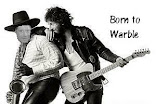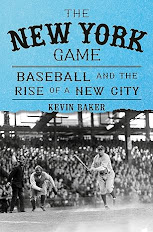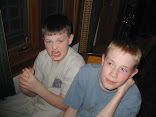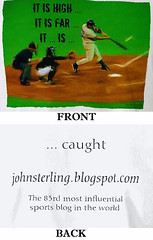Then they came for Giancarlo, and I did not speak out, because - hey, it was frikkin Giancarlo...
Then they came for Bader, and I did not speak out, though I did spit some bile on Cashman, because who trades for a guy who's already out for three months?
And then they came for ME - actually, not me, but Nestor - and fukkit, I've seen enough: It's Clobberin' Time! Release the Kraken! Wake up the gimp! Proceed to checkout! It's time to crack some juju god heads!
This isn't fair, I'm telling you: This. Just. Isn't. Fair. Yeah, I get it that certain players are made of peanut brittle and snap like the lead refill on a mechanical pencil if you sneer at them. And I get it that if your clubhouse card game is canasta, and your walk-up music is Bobby Vinton - (See the tree, how big it's grown...) - maybe we should make peace with a daily body count. But seriously, people... something here is out of whack.
Every day, every single day, we lose somebody. I'm telling you, something is wrong...
Compare the current injury lists, a snapshot that does not show the entirety of lost work time this season.
Baltimore: 9 out.
Boston: 11 out.
Toronto: 6 out
Tampa: 11 out.
And the Yankees: 14 (fourteen) out.
It's been this way all year. The tweak tsunami began in spring training, and it has never halted, not once. I mean... WTF? All season! Unrelenting! They just keep coming.
A few years ago, the Yankees replaced their trainers. Well, it didn't work. So... what is it?
Is it Yankee Stadium? Something with the turf? Is it the stress of NYC? Is it the pavement? The food? The hookers? Look, I'm spit-balling, but something is out of whack.
Should the Yankees try a six-man rotation? (We barely now have five.) Should we teach the knuckleball in our farm system? Should we hire shrinks? Is this mental? Is it a mass psychogenic thingy, something contagious?
I ask, because we do know this: It's not going to stop. We will regularly lose players for the rest of the season, and more so than other teams. We will only be as deep as our backups in Scranton. We will once again see Franchy Cordero, Ben Rortvedt, Greg Weissert, et al. (Though not Estevan Florial; he is gone. Wait... could he be it? Could he have placed a curse on us?)
The tweaks won't stop. Something is seriously wrong. And maybe that's why this weird season - which, technically, hasn't been so awful - feels so jinxed.


















































32 comments:
Baseball's game action and modern conditioning/training methods are to blame. Standing around doing nothing for extended periods of time, interrupted very occasionally by quick, furious bursts of all out, full body effort is a nice formula for pulls, tweaks, strains, and tears.
Earlier generations understood this. They valued very highly, and selected for, athletes whose body type, athleticism and constitution was least affected by this type of game action. Generally, this meant flexible, loose-limbed athletes who understood that staying on the field was itself a valuable quality, so they trained and played accordingly.
No longer. "Burst" and "explosiveness" are the 21st century rage. Training, conditioning and game play emphasizes going from standing almost completely still to maximum possible performance as quickly as possible It makes for hulking, sometimes sculpted bodies, lots of long home runs, and 95 mph breaking balls. It also stresses hamstrings, shoulders, lats, obliques, etc.
So long as baseball training so strongly emphasizes "explosive" power, players will spend tons of time on DL nursing tweaks, tears and strains. An athlete with the body type of the average 21st century baseball player simply can't stay "warmed up" enough during a 3 hour game day after day. Something, at some point, is going to give on one of those max effort swings, dead sprints around the bases, or 25 pitch innings full of 100 mph foul balls.
I agree, Publius. They're all doing weight training now. And it is geared toward developing explosive power. They even get injured while doing the weight training itself. The player of 2023 is much more bulked up than his counterpart from 1978. All one has to do is look at the old film footage from the past to see an enormous difference.
When baseball moved the fences in, that was a big mistake. It was exciting in the short term to see a lot more home runs. But it caused bigger and bigger hitters, with more and more strikeout pitchers. It's resulted in the game we see today.
I would like to see every outfield increased in size by at least 25%. And the mound lowered another 5 inches. And the number of pitchers on every roster should be set at a maximum of 11. Five starters plus 6 relievers should be enough. And they have to tweak the rules with minor league callups to reduce the business of sending players up and down and having a huge reserve pool of guys to cycle in and out.
Even more so than the pitch clock and the ghost runner, these were the kind of rule changes that would have sent baseball in a healthier, less power driven direction.
Judge's foot injury was just pure bad luck. I could tell from his face after he made the catch that he was in pain or at least concerned. He was not smiling or laughing. Now we hold our breaths while they do the x-ray/CT scan/MRI thing. If the toe is broken, that's probably a good two months on the shelf, and we can kiss the wild card goodbye.
I'd love to know how valid the "Verducci effect" has been. It sure doesn't seem that starters are healthier now than twenty years ago. And if it's NOT effective, bullpens are having to throw more pitches per year. Does anyone in these parts know the numbers?
As the musician of the group, I'm compelled to point out that, "See the tree, how big it's grown...) was, in fact, a hit for Bobby Goldboro, not Bobby Vinton.
The song Honey...
An IL stint for Judge seems inevitable. Hopefully not a fractured toe which could easily be 6 weeks out, possibly more, depending on the severity. Even a sprain could mean 2 weeks out.
Cortes’ injury is more mysterious, but a shoulder injury is he worst for a pitcher and could very well cost him the rest of the season. If Rodon has recovered he needs to be pressed into service ASAP. The farm system is empty. Our best consensus prospect, Clayton Beeter, is 2 years away and not throwing enough, because …something, something. Will Warren was promoted to AAA and is getting lit up. Deivi Garcia is bad, as always. A trade you say? It could happen, though not without some kind of pain. Torres is the best bargaining chip with a concurrently expanded role for Peraza. Unless it’s Peraza that gets traded.
And…pssst… don’t tell anybody but LeMahieu is cooked. A sneak preview of what the entire team will look like in 2 years.
Brilliantly put, Publius! And I like those ideas, Hammer.
I think this does get down to how the game gets taught. Baseball needs to get back to teaching pitchers how to "pitch to contact" and batters to do something besides swing for the fences on every pitch.
The old game was simply more entertaining. And frankly, I dispute the entire idea that the new game is somehow "more efficient" or "productive."
It isn't.
Show me where the new game produces "more" or "better" of anything. The only categories are in strikeouts and home runs—and even those vary greatly. Overall runs scored (or prevented), more hits, complete games, pitching wins, etc., etc.?
No.
What the new game is doing is slowly but steadily driving out the individuality. Guys can't stay on the field, so it becomes more and more anonymous, with the players entirely interchangeable.
Instead, we celebrate silly "burst" and "explosiveness" statistics that are largely pointless, such as pitch speed and exit velo. Hurrah.
From Twitter. Maybe we have been too hard on our Yankees...
Yankees Slut
@YankeesSlut
·
14h
To this point in the season the Yankees have played the most difficult schedule of any team in MLB (per PRG), they are tied for the fewest off-days of any team in MLB, and they have played with an all-star roster on the IL.
I believe it is a combination. The Dodgers have an old stadium in a general state of disrepair. Let's hope it is not bad concerning. Judge. Genius Cashman signs or trades for alot of broken down and or injury prone players. When I mention Bader, nine injures in eight seasons, I hear "Top Center Fielders are hard to find." How about developing some young players. Hal is not smart enough. He should take a look at the scouts and personnel of The Braves and Rsy who devlop young talent. If their contracts are expiring, over pay them. He certainly overpaid for the GM.
The Dodgers are one of the wealthiest franchises in pro spots, and while I agree with your assessment, edb, there is no excuse on their part for having a decrepit portion of their stadium which can come in direct contact with a fielder.
The Dodgers should be held accountable for this negligence.
Agreed Archie
How can anyone be surprised by this? Rondon, Stanton, Bader, Johnny Lasagna, Judge, Montas? It's not a question of if they'll get injured, it's when and for how long will they'll be injured for. Again it goes back to building a team and this franchise is clueless.
Centerfielders getting hurt is part of the job description. They have to make the runs that take them to "terminal velocity" the most often, make the do or die diving play in the alleys, the slamming, contorted catches against the wall. It's miracle that, thank God, nobody has ever been killed out there. The men who seem to last the longest are fairly tall, kinda wiry built players. So we don't have to crucify general managers for CF injuries. The organization as a whole seems to believe in explosive athletes who are more likely to get hurt. Track and field athletes aren't generally known for injury free careers. I don't know who the new announcer on the MLB.COM broadcast is, but I caught the tail end of a point that he was making about Yankee pitchers (likely that he was an ex-pitcher). He pointed out that pitchers used to run longer distances so they could go deeper into games. He contrasted that philosophy with more explosive running drills that are the current rage. Hmmmm. Along those lines, when Nolan Ryan became the Rangers he said that his pitchers were going to 'run, run, run'. The staff had some of the best results in club history.
My apologies to Publius, I just saw that I pretty much covered the same territory that he did at the top of the post. I was using a Kindle, unknowingly hit the screen, which rolled downwards.
Regarding BTR999's comment regarding LeMahieu, something is up. His barrel rate is down, and are his exit velocity numbers. Hopefully he's still recovering from last year, and will soon rebound. With the poor barrel rate we'll find out pretty quickly since pitchers will start to really test him. If this turns into a season long issue say goodbye to any reasonable chance of making the playoffs.
True, Kevin. And I would reiterate that pitching to contact is also a lost art. I remember all those blissful Tommy John games, with a crackerjack infield behind him. No one is taught to throw like that anymore. Now it's just, 'Add another 5 mph onto your curveball. Oh, you're going to be out for a year or two because you did that? Well, after that, we'll see!'
Only 23 hours remaining of our national nightmare… and the return of John Sterling.
Publius -- Do you have any empirical evidence that present-day MLB players are more injury-prone than those of previous decades?
And as far as outfielders go, I remember how, not long ago, Bobby Abreu used to be regularly castigated in the press for not crashing the walls in RF.
Yeah, all he did was stay in the lineup, day after day, game after game—2 seasons with 162 games, 13 with over 150—and hit at near-HOF numbers. A typical Abreu year, projected over 162 games (which he might well play), ran like this:
97 runs, 38 doubles, 4 triples, 19 homers, 91 RBI, 27-36 in SB, 99 walks, and a .291/.395/.475/.870 split.
Give me nine Abreus, and I'll win every year.
Reggie Jackson was considered muscle bound in his playing time. He looks like a dwarf against todays players.
But, launch angle and exit velocity...
= 0 when you are on the DL
We need a fan metric… BAOTF. Batting average and “on the fielding”. For every game you miss on the DL, we mix in three strike with your batting average because you’re not on the field.
Let’s take Stanton… 59 AB 16 Hits… .271
But he missed 51 games. 59+153…. That’s .075.
At least Volpe shows up.
My now retired manager gave credit for showing up to work at pay raise time… also for wearing a belt, button down shirt, shoes with laces… he couldn’t handle work from home and retired. Stanton has done the quiet quitting routine.
How how about WAR-cost. I’d you’re X WAR but the guy who actually replaced you is some other number… we figure out some way to discredit you with the difference because YOU WERE REPLACED. What’s your WAR when someone has to replace you?
Volpe showing up is considered a good thing? He is batting .193 with an OPS plus of 74. Enough already with this guy.
BJPB, WAR is a counting statistic so if you don't show up then you are in effect penalised (it's late, so perhaps I am missing something more subtle).
EBD, you are constantly pushing the idea of giving the kids a chance, which in theory makes for a quicker, more athletic team, a cheaper team, and a healthier one. All laudable ideals to be sure. Yet you have been highly critical of Volpe for over a month. Were you expecting Mike Trout at shortstop, or is this some kind of a payback because you don't think there was justice for Florial? Personally I believe that he should be sent down for the mental break. The team has to come first, especially with the lineup that we have, and at this point Florial should come up and put up or get be given to the A's. I don't need to be convinced that Hal and The Brain have designed a Gordian knot of a organization.
EBD, yes there is plenty of empirical evidence showing that the old-timers played in more games. Go to baseball-reference.com and scroll back in time. And astonishing how many innings that many pitchers threw for years on end. There are various excuses as to causation, I find most to be wanting. IMHO, the real reason is that owners don't want their very expensive possessions to get injured. This motive is a great example of correlation being mistaken for causation. The real cause is very few human beings can function, in good condition, under the strains of certain sports when they are always on the edge of being over-trained. Has any human ever been so carefully handled as the great Jacob deGrom? Total shame, but you would think that he went to the same gym as Severino. People are often incredulous regarding my theories (I could really go on), but People are brainwashed by the "bigger,faster, stronger" bullshit has been pumped out by the Sports Industry for the past fifty years. And that's all I have to say about that....
I would like to see a study, not an invitation to "scroll around"--that is not empirical evidence. First of all, the discussion was mostly about the starting eight, not about pitchers--that's another subject altogether. Publius and others were arguing that ALL players were more durable and less injury-prone in decades past. I have never seen a study confirming on this, and Publius stated the case with such certainty that I was sure he must have read one that he could refer us to.
Second, yes, I am all for giving young players more of a chance than the Cashman regime is typically inclined to do. But often the auditions have been too brief, the players get bounced up and down, their confidence is ruined, etc. Volpe has been given more than a third of a season to demonstrate that he is subpar offensively and defensively in the majors--you could look it up easily. His fielding and batting numbers are all well below average. His batting numbers are godawful. He's had more than a fair trial--it's obvious that he needs more seasoning, especially given the reality that Peraza is ready to go and most likely is a better player right now--not two or three years from now.
Now settle down with some chamomile tea and find another person to chat with. I am not inclined to engage with you any further.
Thing about players in the old days, Kevin, is that the evidence is very mixed—especially when it comes to pitchers.
First, pitching loads were not always what they might seem to be, in that pitchers rarely had to throw as many pitches as they do today. Second, there were a lot of guys who seemed to get "sore arms." For years. When that happened, they got sent down, or to the back of the bullpen, and sometimes they found a new pitch, or they just came up with some way to pitch through the pain and get by.
Or they didn't come back at all.
Looking at the Yankees alone, back in the day, offhand you can see that Bob Grim, Johnny Kucks, Tom Sturdivant, Luis Arroyo, Rollie Sheldon, Bill Stafford, Al Downing, Jim Bouton, Hal Reniff, and more, all started out great, got "sore arms"...and were (mostly) never the same pitchers again.
Often, too, the guys who lasted the longest did not pitch much early, for one reason or another (Warren Spahn, for instance, lost 3 years to the war).
But there were, it seems, more exceptions. And I wonder if that's because more of them learned to pitch to contact, and limited the wear and tear.
Day-to-day players...well, let's muse on that soon.
The average fastball in "the good old days" was about 85 mph--now it's close to 95 mph. Moreover, when pitchers warmed up between innings in "the good old days," they soft-tossed, as anyone can see by going to YouTube and watching the pitchers warm up while the ads were superimposed on the high-home image during World Series games. Finally, as HC66 points out, there are endless examples--and not just with the Yankees--of pitching careers truncated because of arm injuries, ranging from Smoky Joe Wood to Bo Belinsky to Denny McLain to Sandy Koufax, and so on, ad infinitum. But when someone is determined to fudge the issue by confusing pitchers with starting eight players, produces no evidence whatsoever--just an invitation to surf the Internet--not even any anecdotal evidence, and can't produce any rigorous studies on the subject, as requested, for me the discussion is over, because it's obvious that we're dealing not with civil discourse but with compulsive provocation.
What makes you feel that I should do some kind of "study" for you? If you can't trust your own eyes, then you won't trust mine.
But study this, there were no studies done before the 'oughts during games. They didn't even have standardized baseball radars. I NEVER SAID ANYTHING ABOUT a lack of injuries.
And WTF compulsive provocation are you referring too? Are you so mentally weak that everything provokes you? I was genuinely trying to be nice, I enjoy looking at the old numbers and hoped that you would as well. Obviously you didn't bother. Which I won't. Waste anymore of my time.
HC, I wasn't trying to imply that pitchers didn't get hurt, and yeah it you got hurt you pretty much got better, or you prayed for a coaching career. But more pitchers threw by far more innings than pitchers do today. An "average" starter made more starts and threw more innings than anyone does now. Four man rotations coupled with innings was to that. I've read some interviews going forward that pitchers would save their strength and use their best stuff according to the game/hitter situation. You picked up on a great point that Bill James did a study on in the early eighties. The study was on pitchers and catchers. Like you, James noticed that pitchers and catchers who came up young, and especially if they were worked hard burned out young. He theorized (I be would think that he spoke to medical doctors as well) that connective tissue didn't on average fully develop until age 25. He pointed out many examples, noting that sometimes mild injuries that kept players off the field could have long lasting benefits. I remember James pointing out that Munson was pretty shot as a catcher when he,unfortunately, was killed, while Fisk and Bob Boone lasted forever, both having had many injuries when young. Obviously this was not meant to be all inclusive, but still it was of statistical significance.
Another aspect is guaranteed, long-term contracts. In earlier eras players were undoubtedly tempted to "play through" injuries that today would lead to a DL stint. The prospect of losing one's livelihood, a livelihood which in general did not contemplate compensation for long term injury, was likely a very strong incentive to stay on the field in all but the worst cases of injury.
These days, the incentives are reversed. At the merest hint of discomfort, a player with a guaranteed contract likely thinks sitting out and healing up completely is the wiser course of action. Why risk getting worse? He'll keep getting paid for the life of his contract regardless. There are degrees of risk calculation here of course, but the incentive to recuperate fully is much stronger now than in earlier eras. And this is entirely to the good, from a job security stand point. A great achievement by organized labor. One bit of bad luck doesn't raise the prospect of a player's family tumbling into poverty.
But, together with training regimens and performance expectations which emphasize burst and explosiveness, the average modern major league ballplayer's job security creates an extremely injury-risk averse environment.
In short, I think it very likely for instance that a) Giancarlo Stanton would have had a different training regimen a few generations ago and would therefore not have been so susceptible to his manifold tweaks, stains and pulls, and b) if he did still suffer from some amount of tweaks/strains/pulls, he'd lose significantly less playing time recovering from them.
Post a Comment